It’s been called a “limitless” source of energy by advocates, and “volcano fracking” by critics - but exactly what is geothermal energy?
From the Core of the Planet
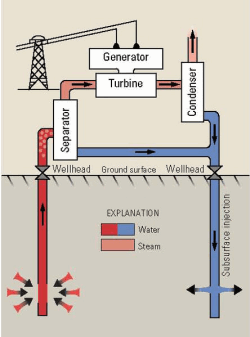
Diagram illustrating power generation from a hot-water hydrothermal system (Photo credit: US federal government)
The term actually defines itself: “geo” refers to earth, and “thermal” means heat. A geothermal power plant extracts heat from deep within the earth. The intense heat from hot magma rises, which boils pools of water buried in crust rock.
The water then generates high-temperature steam that spins turbines in a power plant onsite. The energy is ultimately sourced from the feverish core of the planet, which produces a virtually eternal source of intensive heat.
Conventional geothermal production features virtually zero emissions and creates no harmful byproducts. Additionally, this source is not subject to the vagaries of wind and solar - geothermodynamics work full-time, year-round. While the sun doesn’t always shine, and the wind doesn’t always blow, geothermal currents never stop moving.
Geothermal energy production is reliable as long as seismic activity and magma flows remain at low levels; this makes geothermal energy an extremely attractive renewable energy source. Let’s take a look at how the emerging science of geothermal extraction actually works.
Development Boom
According to an air emissions analysis published by the Geothermal Energy Association, hydrothermal production is a big boon to public health as well as the environment. The U.S.-based trade group’s data suggested that California and Nevada save some $117 million annually in diverted pollution by developing geothermal energy.
Geothermal works are filling a surfacing market that has caught the attention of companies and governments worldwide. From Turkey and Indonesia to France and East Africa, nations are increasingly investigating and developing their own geothermal resources.
Meanwhile, the UK hopes to construct a huge vulcan underwater pipeline from Iceland to its own shores in a bid to access cost-effective exports of the cheap, greenhouse gas-free energy source.
How Does It Work?
Conventional Operations
How does geothermal energy work? There are two basic models of geothermal production, and their usage depends first and foremost on the real estate at hand. In the richest reservoirs, there is enormous potential for local energy independence and sustainability. The heart of Iceland, a “land of fire and ice,” is a perfect case-in-point.

Nesjavellir Geothermal Power Plant in Iceland (Photo credit: Gretar Ivarsson)
Here, you can dig a deep well and simply plant a production facility on top. Steam power is constantly available from ever-boiling underground water. “Enhanced” extraction techniques aren’t necessary in a place where the earth’s hot magma readily intrudes through the crust and hot springs freely flow.
The North Atlantic island itself is a product of these processes over geological history. It straddles the seam separating the American and European tectonic plates, which are slowly being torn apart over time. That’s why geothermal works so well for Icelanders: it’s local, abundant and cheap.
Today, it is a huge part of how the nation maintains one of the world’s only 100% renewable electricity grids. Big glass greenhouses sprinkle southern Iceland, using heat from below to grow food that could not otherwise survive in the above-ground climate.
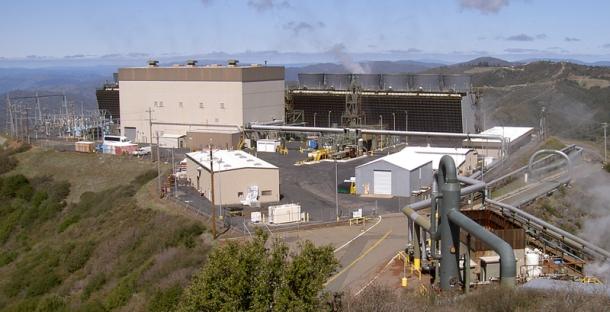
Sonoma Calpine 3 geothermal power plant at "The Geysers" (Photo credit: Wikipedia)
More rarely, earthen power comes from dry rocks superheated by underground water, most notably north of San Francisco, California in the “Geysers.” Here, 22 plants and 350 wells collectively produce the world’s largest geothermal output. The installation provides electricity to several hundred thousand local homes, pollution-free.
Enhanced Operations
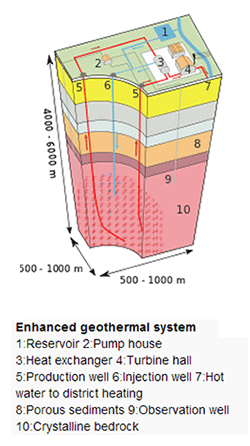
Diagram illustrating an enhanced geothermal system (Photo credit: Wikipedia)
Most places lack the abundant natural springs that fuel conventional geothermal installations. Currently, a wave of commercial projects is underway to overcome these built-in limitations, using an emerging technology called “Enhanced Geothermal Systems” (EGS) to extract magma-warmed heat from artificial reservoirs.
EGS is still in the early stages of research and development, but promises exponential returns compared to traditional geothermal methods. It could be a viable way to bring geothermal energy into mass production. However, the technique is not without risks.
EGS has been associated with some negative ecological impacts. While a true geothermal reservoir is a source of naturally heated water, EGS involves fracturing bedrock and injecting the cracks with water where none exists. This process has been linked to induced earthquakes and groundwater contamination.
The Future of Geothermal Energy
Conventional geothermal power shines as a high-potential source of cheap, clean and sustainable baseload power for stressed electrical grids. Meanwhile, “enhanced” geothermal operations have large-scale potential, but the cost-benefit balance is still unclear.
Overall, geothermal represents a positive step toward renewable power. It doesn’t get much more clean and reliable than the steam continously formed by the earth’s rocks and all-natural hot springs.
author: Emily Silva categories:
- Environment date: 2013-05-30T14:37:15Z guid: https://curiosityaroused.com/?p=716 id: 716 thumbnail: wp-content/uploads/puhagan-geothermal-plant-420x409.jpg title: ‘Geothermal Energy: Pros and Cons’ url: /environment/geothermal-energy-pros-and-cons/
When we use solar panels to capture the sun’s radiation, we are going out of our way to do something the earth already does everywhere around us: capture and store solar energy. In fact, about half the solar radiation that hits our planet ends up in the ground. In this sense, geothermal energy represents a secondary source of sun power.
The Earth’s underground layers also harbor the heat of the distant past, beaming out from the flaming core of the planet. Between the core and the surface, geological layers act as a natural heat exchanger, convecting high temperatures upward. Melting rocks lend their fire to water that has filled underground reservoirs. If you’ve ever enjoyed natural hot springs or visited the geysers at Yellowstone, you’re familiar with one manifestation of this process. You can read more about what geothermal energy is and how it works here.

Nesjavellir Geothermal Power Plant in Iceland (Photo credit: Gretar Ivarsson)
Does it make sense to harness these forces to ward off the chill and run all our gadgets? There are several geothermal energy advantages and disadvantages that require our attention. Let’s take a look at the top pros and cons of geothermal energy to get a sense of its role and potential. We will pay special attention to its efficiency, reliability, economic cost and impact on the environment.
Efficiency

Ground source heating and cooling (Photo credit: Wikipedia)
Is geothermal production energy-efficient? You bet. In the Northeastern U.S., for instance, a basic home geo-exchange system can reach efficiencies of up to 600%, compared to the average 90% performance of a conventionally-powered unit. Subterranean wells can also improve building economy by replacing separate heating and cooling units with a single earth-powered system.
Keep in mind that different thermal systems have different levels of efficiency. The scale of a project and numerous installation factors bear on the upper range of what is attainable in real world conditions. Matching local geology with the right type of system is essential for maintaining an efficiency-optimized process.
Reliability
Advocates of geothermal power are proud to get behind one of the world’s most reliable energy sources. With an enduring supply of naturally replenishing heat, geothermal power remains stable all day, all night, and across the seasons. Reliability is crucial for maintaining a steady supply of electricity to homes and businesses. Because it is so consistent, geothermal energy can easily be used for base loads or sharp spikes in demand.
Pipeline-free geothermal development also requires the smallest total land use of any energy source, making it potentially viable for urban usage at great enough depths. As many realized in the aftermath of last year’s “superstorm” Hurricane Sandy, having all critical energy-supplying equipment underground is indispensable during gale-force winds and madcap floods.
Because the principles and setup are mechanically simple, maintenance over time is minimal and life expectancy is long. In fact, every geothermal energy facility built in the last century is still operational today.
Costs
Is geothermal power production cost-effective? Yes: normally it is cost-effective over a relatively short time frame. However, geothermal energy pros and cons alike arise in the area of economic feasibility.
Earthbound power contributes to the grid, and it is increasingly being used to directly supply commercial and residential buildings. In either case, the up-front costs are high–a major con. However, the return-on-investment grows many times higher over the course of a few decades. Further, relief from the initial expenditure is quick: once established, utility savings can immediately begin to offset startup costs.
An expanded geothermal operation poses additional cost challenges. Larger-scale production wells drill deeper for more intense heat, 5k to 10k feet below the surface. These operations are more expensive, with greater depth usually translating into a higher price tag. If exploration is necessary, these costs can become prohibitively expensive.
These technological and financial geothermal energy disadvantages partly explain why earth’s natural heating is not in wider use today: it is largely limited to reasonably accessible, hydrothermally-rich zones. In other words, what you need for a cost-effective geothermal project is underground water within range.
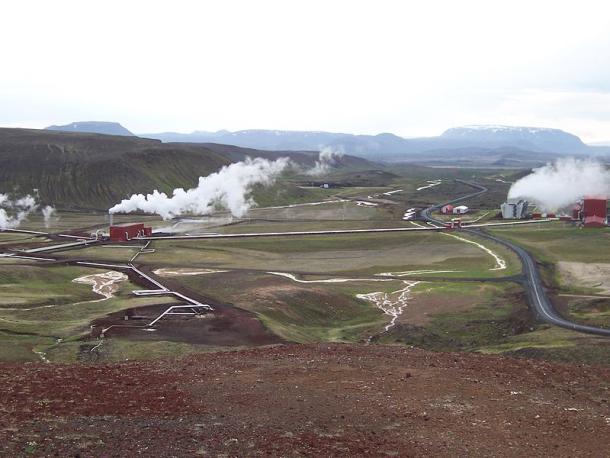
Krafla Geothermal Station in Iceland - the most hydrothermally-rich country in the world. (Photo credit: Wikipedia)
The conditions for cost-effective production do not exist everywhere. While it is true that you could drill a well several miles down just about anywhere for virtually endless, high-temperature energy, most of the time it would be too expensive. The process of exploring, drilling and utilizing dry heat buried deep underground is exorbitant with current technologies. So the virtual infinity of geothermal heat is ultimately capped by cost.
However, an emerging trend in extraction called “enhanced geothermal systems,” or EGS, promises to develop resources anywhere, regardless of natural potential. EGS, which fractures rocks to create artificial hydrothermal reservoirs, has been linked to induced earthquakes and chemical pollution. So far, it seems “enhanced” methods can only buy geothermal’s universality at the expense of its eco-friendliness.
Environment
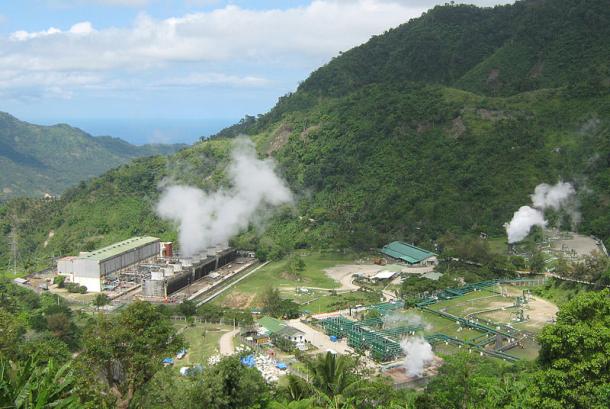
Puhagan Geothermal Plant in the Philippines (Photo credit: Wikipedia)
Is geothermal energy good for the environment? Definitely. This form of energy is renewable–with proper management. While it is possible to deplete underground water resources by extracting too much at a time, this should not be a threat to a well-managed operation.
Geosystems are designed to be sustainable, by injecting water not “flashed” into steam back into the ground where it came from. A steady supply is thus easily achieved with hydrologic stewardship and properly installed infrastructure.
That geothermal energy is typically produced locally is another boon to Mother Earth. Eliminating the enormous ecological costs of transporting fossil fuels from faraway lands is one of the key advantages of piping in heat from underneath your feet. Not to mention, there aren’t any pollutants to escape geothermal facilities because there’s no fuel subject to combustion.
Weighing the green advantages and disadvantages of geothermal energy, it’s clear hydrothermal methods deserve a round of applause for their holistic contribution to a safer and cleaner environment. As a clean, reliable and cost-effective way to power up society, earth’s own radiant heat seems to have a bright future ahead of it in the broader energy mix.